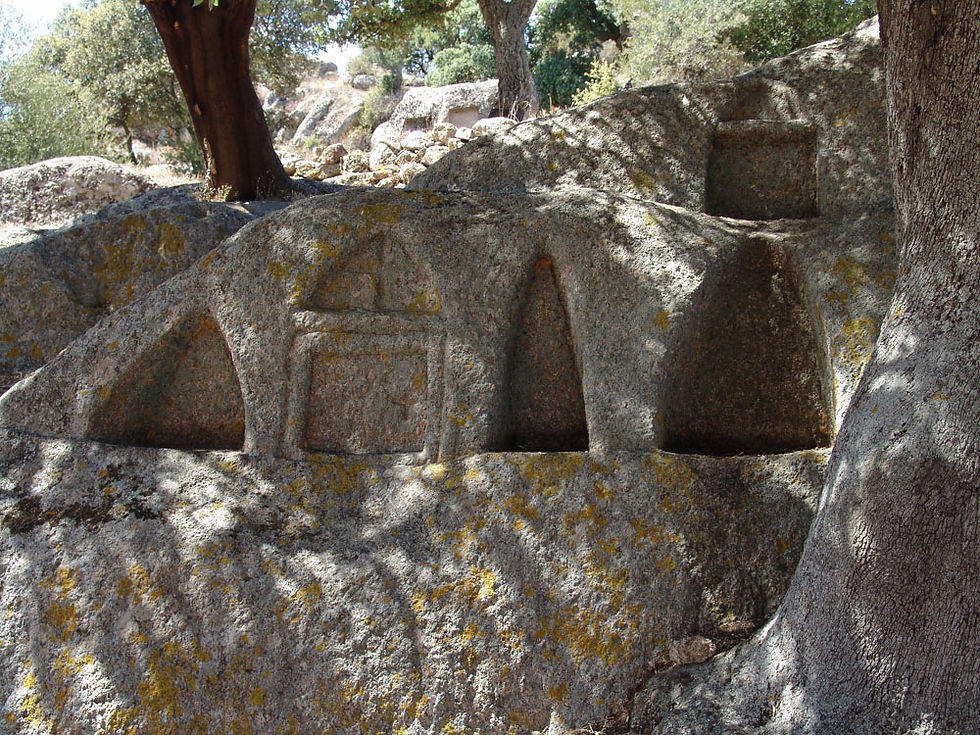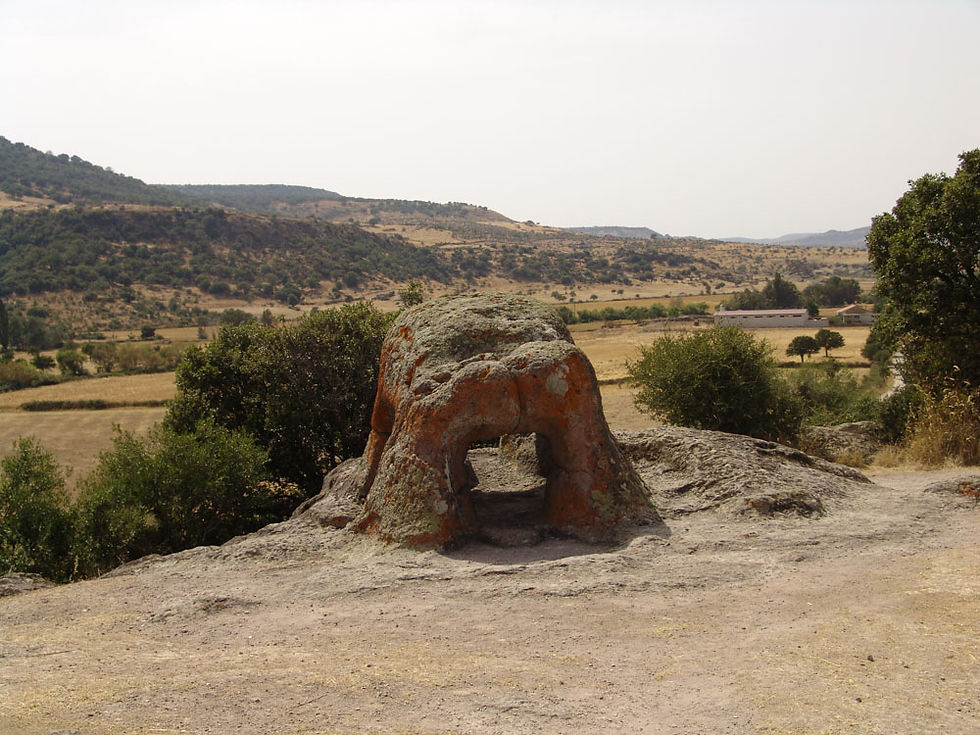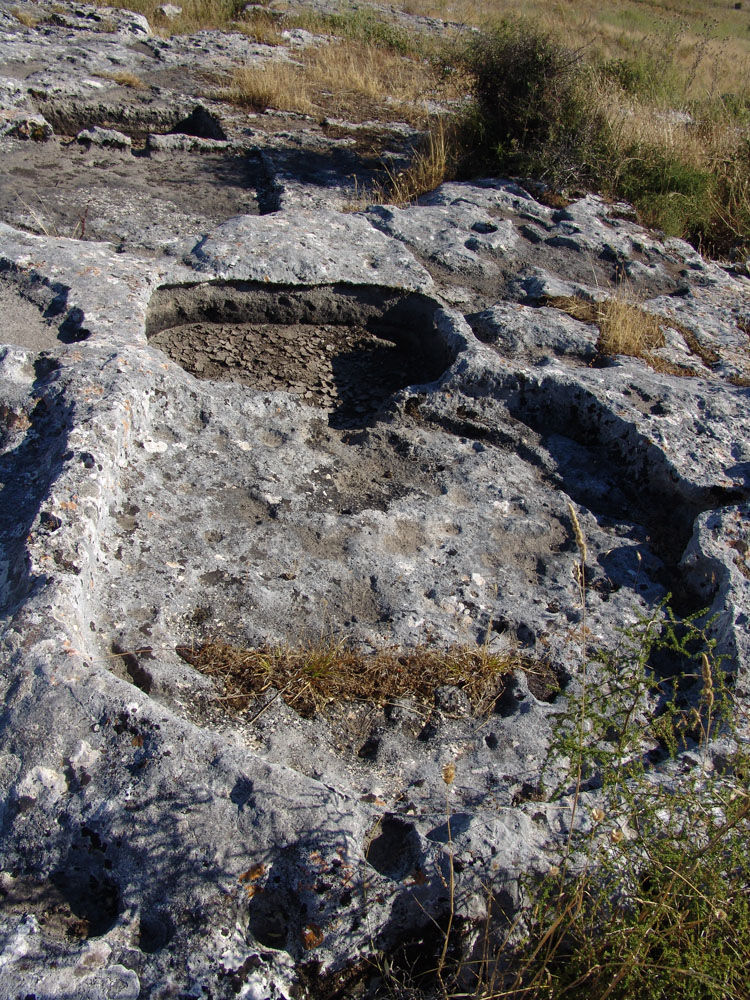
NURAGIC CULTURE
Sardinia, ITALY
Sito rupestre di Santo Stefano (Oschiri) - 3500 to 2700 BC






The Sito rupestre di Santo Stefano, located in Oschiri, Sardinia, Italy, is an archaeological site consisting of a rock shelter adorned with prehistoric rock art. Dating back to the Neolithic period, approximately 6,000 to 3,000 years ago, the site features intricate carvings and paintings depicting scenes of daily life, religious rituals, and symbolic motifs.
Excavations and studies at the Sito rupestre di Santo Stefano have revealed evidence of ancient human occupation, including the remains of hearths, tools, and pottery fragments. These archaeological findings provide insights into the lifeways and cultural practices of the prehistoric communities that inhabited the area.
The rock art at Santo Stefano includes depictions of animals, humans, geometric designs, and abstract symbols, reflecting the spiritual beliefs and artistic expression of the Neolithic people. The site's location within a natural rock shelter suggests it may have served as a sacred or ceremonial space for the local community.
Today, the Sito rupestre di Santo Stefano is a protected archaeological site and a valuable cultural heritage asset for Sardinia. Visitors to the site can explore the rock shelter and admire the ancient rock art, gaining a deeper appreciation for the rich prehistoric heritage of the island.
Sant'Andrea Priu - 3500–2900 BC






Sant'Andrea Priu, located in Sardinia, Italy, is an archaeological site renowned for its remarkable collection of prehistoric rock-cut tombs, or domus de janas, dating back to the Neolithic and Bronze Ages. These chambered tombs are carved into the limestone cliffs of the area and are adorned with intricate carvings and reliefs depicting symbolic motifs and religious scenes.
Excavations and studies at Sant'Andrea Priu have revealed evidence of ancient human occupation, including the remains of settlements, tools, and pottery. The site's strategic location near water sources and fertile land suggests it may have been an important center for agriculture, trade, and ritual activity in prehistoric times.
The domus de janas at Sant'Andrea Priu are notable for their architectural complexity and artistic embellishments, which include anthropomorphic figures, animal motifs, and geometric designs. These rock-cut tombs provide valuable insights into the spiritual beliefs and funerary practices of the prehistoric inhabitants of Sardinia.
Today, Sant'Andrea Priu is a protected archaeological site and a popular destination for visitors interested in exploring the island's ancient past. Guided tours and interpretive displays offer insights into the significance of the domus de janas and their role in the cultural and religious landscape of Neolithic and Bronze Age Sardinia.
Nuraghe Santu Antine - 19-18th century BC






Nuraghe Santu Antine, located in Sardinia, Italy, is one of the island's most impressive and well-preserved nuraghi, ancient stone structures dating back to the Bronze Age. Built around 3,500 years ago, Nuraghe Santu Antine stands as a testament to the architectural and engineering prowess of Sardinia's prehistoric inhabitants.
Excavations and studies at Nuraghe Santu Antine have revealed evidence of complex architectural features, including a central tower surrounded by multiple concentric walls, chambers, and corridors. The purpose of nuraghi like Santu Antine remains a subject of debate among archaeologists, with theories ranging from defensive forts to religious or administrative centers.
The impressive size and intricate construction of Nuraghe Santu Antine suggest it may have served as a symbol of power and authority for the local community, as well as a focal point for social and religious activities. The site's strategic location overlooking the surrounding landscape further underscores its significance in the Bronze Age Sardinian landscape.
Today, Nuraghe Santu Antine is a UNESCO World Heritage Site and a popular tourist destination, attracting visitors from around the world to marvel at its ancient stone architecture and learn about the island's prehistoric past. Guided tours and interpretive displays offer insights into the construction techniques, cultural significance, and enduring legacy of Sardinia's nuraghi.
Domus de janas di Tennero - 4000 to 1000 BC






The Domus de janas di Tennero, situated in Sardinia, Italy, is an archaeological site comprising a series of rock-cut tombs dating back to the Neolithic and Bronze Ages. These domus de janas, or "house of the fairies," are ancient burial chambers carved into the limestone cliffs of the region, adorned with intricate carvings and reliefs depicting symbolic motifs and religious scenes.
Excavations and studies at Domus de janas di Tennero have revealed evidence of ancient funerary practices, including the remains of individuals buried within the tombs along with funerary goods such as pottery and tools. The site's location near water sources and fertile land suggests it may have been an important ritual and ceremonial center for the local community.
The domus de janas at Tennero are notable for their architectural complexity and artistic embellishments, which include anthropomorphic figures, animal motifs, and geometric designs. These rock-cut tombs provide valuable insights into the spiritual beliefs and cultural practices of the prehistoric inhabitants of Sardinia.
Today, the Domus de janas di Tennero is a protected archaeological site and a significant cultural heritage asset for Sardinia. Visitors to the site can explore the rock-cut tombs and admire the ancient carvings, gaining a deeper appreciation for the island's rich prehistoric heritage.
Arzachena Tempietto di Malchittu - 3400 to 1100 BC c.






The Tempietto di Malchittu, located in Arzachena, Sardinia, Italy, is an archaeological site featuring a unique prehistoric structure dating back to the Bronze Age, around 4,000 years ago. This enigmatic monument, known locally as the "Little Temple of Malchittu," consists of a small circular chamber carved into the natural rock formation.
Excavations and studies at the Tempietto di Malchittu have revealed evidence of ancient human occupation, including pottery fragments, tools, and ritual objects. The site's location within a larger ceremonial landscape, including nearby nuraghi and rock-cut tombs, suggests it may have been an important religious or ritual center for the prehistoric communities that inhabited the region.
While the main focus of the Tempietto di Malchittu is its unique architectural features, there are no elaborate carvings or motifs present within the chamber. Instead, the monument's significance lies in its construction method and its integration into the natural rock formation, highlighting the ingenuity and craftsmanship of its Bronze Age builders.
Today, the Tempietto di Malchittu is a protected archaeological site and a valuable cultural heritage asset for Sardinia. Visitors to the site can explore the chamber and admire its architectural simplicity, gaining a deeper appreciation for the island's rich prehistoric heritage.



